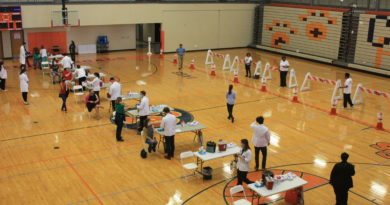The Potty Problem
The school bathroom can be a breeding ground for germs. Every time a student touches the door handle, the sink, or the stall door, germs spread and pass around illnesses, leading to increased absences.
The bathroom should be a clean place where a student can use the restroom without the fear of a broken stall door or a toilet that won’t flush, and with over 1,600 students using the restrooms on a daily basis, they receive heavy traffic.
“I’m a firm believer that a better environment produces better behavior and produces more ownership,” said Principal Deanne Varitek
Aware of the wear and tear on bathrooms throughout the year, Varitek and a group of other administrators and staff walked the entire campus to inspect each and every bathroom and stall as summer came to an end.
“We tried every single lock and faucet, and we flushed every toilet. As a result of that we had a two page list of things that needed to be repaired. We fixed everything, and now here we are in October, broken again,” said Varitek.
Things may be mean to be broken, but students bear some responsibility for the state of the restrooms. A survey conducted by BluePrints revealed that students regularly use restroom facilities on campus, but they are not satisfied with the conditions. On average, 68% of students use the restroom 1-5 times a week, and out of all students 83% wash their hands after using the restrooms.
“Hand washing is key. If we’re not washing hands we’re going to get sick,” said Eve Bisard, Cedar Shoals school nurse.
However, in the women’s and men’s restroom in the CD200 commons, the sink’s motion sensors don’t work. In every male bathroom in the main school building, at least one faucet that doesn’t come on.
The sinks are not the only problem in the CD200 women’s restrooms. On the second stall closest to the entrance, a ring of green mold circles around the water seal of the toilet.
“The restroom is where germs harbor. It’s important to keep it clean that way students, faculty, administrators, and other people don’t get sick,” said Ron Thompson, custodial staff.
The custodial staff has a specific cleaning process for the bathrooms to rid them of germs.
“It takes about twenty minutes per restroom,” says Thompson. “We’re on a green program so that’s what we use. You can clean the restroom two ways. One is the KaiVac where you spray the bathroom with a chemical that cleans all the germs in it. Then you vacuum it out. Another process is wiping it down thoroughly with the same chemicals.”
In the downstairs boys’ restroom near the cafeteria, the porcelain is completely broken on one toilet. An out of order sign hangs the stall door, but that hasn’t stopped students from taking pictures of the broken toilet.
Broken stall locks are common, too. Some locks will no longer budge or the latches are bent or broken. In both the upstairs CD and AB hall bathrooms there was at least one lock that was no longer functional. A lack of privacy may cause students to avoid restrooms or rush to use them. Holding in urine isn’t good for the body. It can leave the body more vulnerable to bladder infections.
“We have worked with the district advocating funds for improving different parts of the school, and they’ve begun the process for improving those parts. The restrooms are certainly on that list. Within the next 6-12 months they’re going to start the efforts to take our suggestions for improving the bathrooms,” said Assistant Principal Aaron Carter.
Administration and teachers are aware of these issues, even though most of them are actually recent.
“We had a work order put in for the broken toilet, three inoperable urinals, and one screen missing. We ask our supervisors to look at it and put in a work order for it. There’s no excuse for it not to be fixed. From the district level it’s mostly inspections on the custodian’s part,” said Ted Gilbert, Associate Superintendent of District Services.
Funding impacts how a school’s custodial team functions. The Clarke County School District currently budgets $5,322,838 district wide for the 2017-18 school year. That number may seem huge at first glance, but it’s distributed over 21 schools and over 5,074 students.
The whole custodial department has over 125 people. Additionally, $367,102 of their funding goes specifically toward cleaning supplies and equipment such as the Kaivac. Staffing is also important. Last year Cedar had 13 custodians, and this school year we have 15.
“It’s built off of the people that we have plus the people that we ask for as additional staff. This year we asked for one or two more custodians. We decided that of a rule of thumb, that every 22,000 square feet there is one custodian,” said Gilbert.
Reporting a bathroom issue does not have to be complicated. Mrs. Varitek will even accept being notified by e-mail — even from a student.
“I don’t want you guys in a building that looks terrible. I want students to tell me about these issues immediately, because we’ll be on it,” said Varitek




